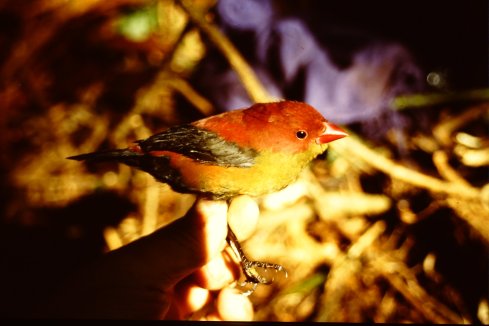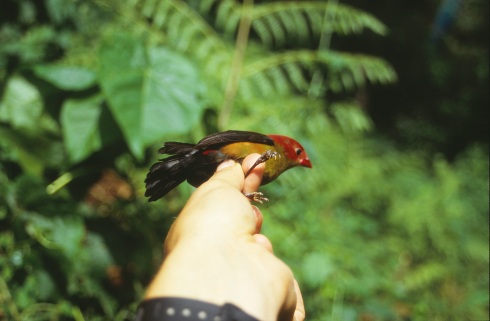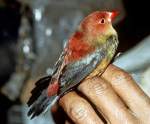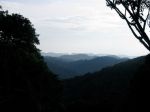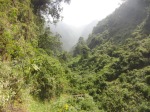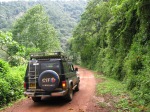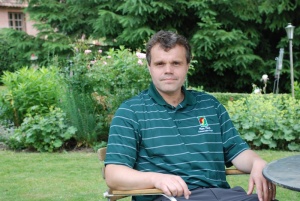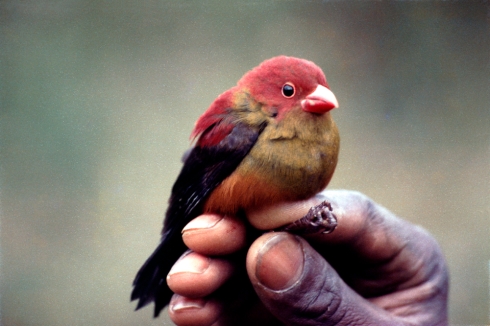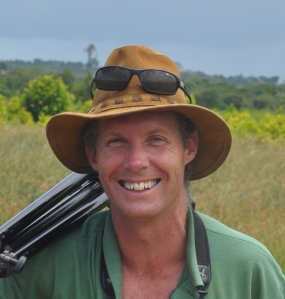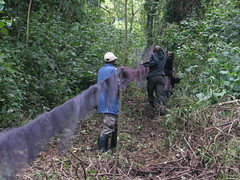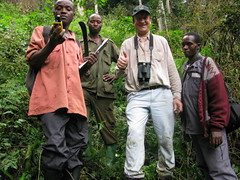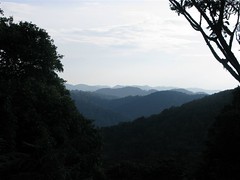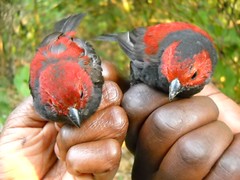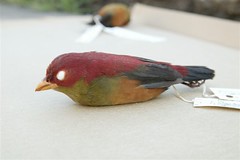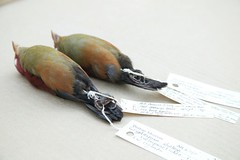-
Eureka! The Rare Finch Conservation group (RFCG) has received two new photos of a Shelley’s Crimsonwing! The photographs taken in 1996 by Morten Dehn from Denmark represent a valuable addition to the sparse visual evidence of Africa’s rarest finch.
Shelley’s Crimsonwing (Cryptospiza shelleyi) is a colourful and elusive bird. Only a few people have ever seen a Shelley’s Crimsonwing in the montane forests of the Albertine Rift Valley, where it is endemic and categorized as Vulnerable by the IUCN Red List of Threatened Species, checked on July 2016.
Although scientifically described more than 100 years ago (Sharpe, 1902), what we know about this bird is minimal, to say the least. Almost nothing is known about its natural behaviour, diet and breeding ecology. While it probably never was a very common bird, there is some evidence that the population has dramatically decreased since the 1970s; possibly because of on-going habitat destruction, but the reasons are unclear and require further investigation.
In 2005, the RFCG adopted the Shelley’s Crimsonwing as the rarest African finch to champion conservation actions and raise awareness for the Shelley’s Crimsonwing. At that time, not a single photo of a live Shelley’s Crimsonwing was known to the RFCG.
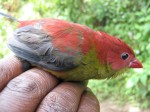
Shelley’s crimsonwing. Photo courtesy http://www.gorilla.org 2008
Simon Espley, one of the founding members, found the first known photograph of a Shelley’s Crimsonwing on the homepage of The Gorilla Foundation (www.gorilla.org). The Foundation reported that they had mist-netted and photographed a male bird in the Virunga National Park (DRC) in 2008. Subsequently during 2009 and 2010 the RFCG, with funding kindly received from the Hans Hoheisen Charitable Trust, started to do extensive fieldwork in search of Shelley’s Crimsonwing in the Bwindi Impenetrable Forest National Park (Uganda). Unfortunately, no Shelley’s were found.
However, the attention of the first known photo and the report the RFCG published and shared with various important conservation organisations helped to raise public awareness for this species, which had been flying under the radar of many ornithologists, birders and twitchers for a number of years.
As a result of this exposure, the RFCG was contacted in 2014 by Colin Jackson, from Kenya, who reported that he had mist-netted and photographed a male Shelley’s Crimsonwing in 1997 whilst on a museum field expedition primarily surveying gorillas in the Virunga National Park, DRC.Colin very kindly donated his photo of the Shelley’s to the RFCG
(http://africageographic.com/blog/the-only-two-known-photos-of-a-live-shelleys-crimsonwing/). Later, another photo of a Shelley’s Crimsonwing was uncovered by the RFCG at the renowned natural history museum, The Field Museum (Chicago, USA). Co-workers David Willard and Tom Gnoske of The Field Museum took the photo whilst on an expedition in the Rwenzori Mountains National Park in 1990 and 1991
(https://rarefinch.com/2015/10/30/a-great-new-photo-of-a-shelleys-crimsonwing/).
The two latest photographs received , as seen above, were taken by Morten Dehn, together with his colleague Lars Christiansen, whilst doing their MSc work at the University of Copenhagen, Denmark performing a survey of the altitudinal distributions of montane forest birds in the Rwenzori Mountains National Park, Uganda. During surveys between July and the beginning of December 1996, Dehn and Christiansen mist-netted birds in the Mubuku/Mahoma/Bujuku River valleys at altitudes between 2100 and 3000 m. ( These overlapped the regions surveyed by researchers of The Field Museum in 1990 and 1991.). A total of five male Shelley’s Crimsonwing were captured. One of them was photographed from two different angles ( photos 1 and 2 above). The two researchers stated that Shelley’s was by far the rarest of the four Crimsonwing species captured during their survey, which yielded only 5 out of the 76 Crimsonwing captured.( The four crimsonwing species are ; Red -Faced Crimsonwing cryptospiza reichenovii , Abyssinian Crimsonwing Cryptospiza salvadorii, Dusky Crimsonwing Cryptospiza jacksoni and the Shelley’s crimsonwing Cryptospiza shelleyi )
Like the other known photos, the bird was again hand-held when photographed. Photo 1 shows a side view, photo 2 a more unusual angle, allowing a ventral view that shows the under parts relatively well. This might be one perspective of the bird to be seen when encountered in the wild. Despite the colourful nature of the plumage, there is no doubt that the green, yellow ochre and black under parts provide good camouflage in the dense understory where the birds seem to linger most of the time. The red of the head and nape on this bird appears to be more even and continuous than what could be seen on the bird photographed by The Field Museum co-workers Willard and Gnoske in 1990 / 1991, suggesting that this may represent an older male. In particular on photo 2, the red of the head/nape really stands out and contrasts well with the greenish colour of the background. Therefore, if we were lucky enough to see a male it would probably be the red colour that would catch our attention.
Although 20 years old, the photos kindly donated by Morten Dehn are a great find and confirm that awareness for this little-known species has grown and is reaching previously unknown people who have worked on Shelley’s Crimsonwing. They are able to add valuable data to our sparse knowledge.
Interestingly, all the known photographs were taken in the 1990’s, with the exception of the male Shelley’s Crimsonwing photo taken in 2008
During 1990, a total of 25 birds were mist-netted, a number based on extensive research and publication consultation. Despite continuous efforts, the last 20 years have yielded only one male bird. Many experienced bird guides the RFCG talked to, who for many years have entered Shelley’s habitat every day, have never seen the species or say it’s extremely rare to see.
The estimated population size as stated in the IUCN Red List fact sheet for Shelley’s Crimsonwing is still 2,500 to 10,000. Conservatively, one may assume a population decline since the 1990s, based on the RFCG’s findings and conclusion after years of research and awareness campaigns.We urgently need more insights into the actual population size and distribution of Shelley’s Crimsonwing, its diet and its natural behavior to inform further conservation recommendations before this elusive and almost unknown species vanishes in silence.
Now that awareness is increasing, more people may try to take photos of a female bird, immature birds or perhaps even a nest. I cannot wait to see this.
For the RFCG: Prof. Sven Cichon, PhD (Basel, Switzerland)

Morten Dehn of Denmark, who together with Lars Christiansen did field work to survey the altitudinal distributions of montane forest birds in the Rwenzori Mountains National Park, Uganda, back in 1996 (courtesy Morten Dehn).
SEE – CONSERVE – ENJOY
Danish researcher shares two new important Shelley’s Crimsonwing photos with the RFCG!
4 AugOnly a few places left on the expedition to help search for Africa’s most elusive finch
22 Dec-
What is Africa’s most elusive bird species ? By Dr.Chris Lotz
When asked the question “what is Africa’s most elusive bird species”, most birders would answer that it must be any of the flufftails, which are, of course, notorious. Or, perhaps they might answer that it could be one of the two pitta species lurking on this continent. But, given a systematic approach, it is actually quite possible to find and even photograph every single flufftail species given a few weeks of travel across Africa and Madagascar. Even the Critically Endangered Slender-billed Flufftail can be reliably seen with a bit of effort – As for the pittas, they certainly aren’t in any way easy, but we usually do find both species annually – our success rate for African Pitta in Mozambique and Green-breasted Pitta in Uganda must be about four in five attempts. At the start of the breeding season, we have exact stakeouts for these jewel-like species and so we’ve kind of “mastered” them and they no longer escape us.
Fewer birders would guess that the bird that we simply can’t find is a splendidly-colored finch occurring at extremely low densities in a tiny part of central Africa.

Shelley’s crimsonwing. Photo courtesy http://www.gorilla.org
While local birding guides in Uganda report the species every couple of years, there are only three known photos of the bird in the world. ( All are held in the hands of a field researcher and all are cock birds. There are currently no known photo references of a hen bird ) And we have never found one on any of our tours yet (despite the fact that we do marvelously well on all the other rare and localized species in the region). The finch we are talking about is the Shelley’s Crimsonwing (Cryptospiza shelleyi), an Albertine Rift Valley endemic with a total world population estimated at anything between 2500 and 10000 individuals.
The Albertine Rift is a westward branch of the famous Great Rift Valley, and it boasts a large number of endemic bird species occurring only in a tiny part of Africa where four countries meet: Uganda, Rwanda, Burundi and the Democratic Republic of the Congo (DRC).
The beautiful and spectacularly bio-diverse, forested mountains of the Albertine Rift straddle the border regions of these four countries. Shelley’s Crimsonwing is one of these Albertine Rift endemics skulking in the undergrowth of the mountain forests here. The DRC is a dangerous place to visit, and most birders focus on either Rwanda or Uganda when they want to find this rare finch. (But find the bird they don’t…!)
Classified as Vulnerable by Birdlife International, Shelley’s Crimsonwing is so poorly-known that scientists do not even have much of an understanding why it is so rare, and why it is apparently declining (also with very fluctuating numbers from year to year). The guess is that habitat destruction by humans is the main culprit, but it has also often been said that the species might be declining due to natural causes, albeit mysterious and puzzling ones!
Where to look for it:
- We wish we knew!
- However, it is known (among other places) from the following legendary birding forests (all of which are also famous for mountain gorilla trekking
-
-
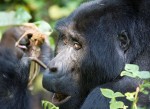
Threatened Mountain Gorilla ( Gorilla beringei.beringei ) photo taken by Cheryl Mares and kindly donated to the RFCG
Nyungwe Forest in Rwanda
- The Mgahinga Gorilla Reserve straddling the border between Uganda, Rwanda and the DRC – this is often considered a top site within Uganda for the crimsonwing, but the reserve is often inexplicably ignored by many birding tour operators. But, we do visit this site annually, partly because it is one of the most accessible sites for the incomparable Rwenzori Turaco (which we reliably DO find, unlike the crimsonwing!). With the spectacular Virunga Volcanos as a backdrop, Mgahinga is certainly not an unpleasant place to spend a couple of days…!
-
- Bwindi Impenetrable Forest in Uganda – this is where several sightings over the last few years have been, including a nesting pair that gave a good number of birders a look (practically “twitchable”) – but one also has to understand the story might have been exaggerated like a fishing tale (no photos were taken!). The long walk down to Mubwindi Swamp at the Ruhizha section of Bwindi – compulsory for seeing another of Africa’s most desirable birds, African Green Broadbill – is probably best. The good news about Bwindi is there are no less than 43 finch species that can be seen in this tropical rain forest.
Why not join us in August 2016 to help look for Africa’s most elusive finch ? Only a few places left.
Day 1: Aug 22. Arrival at Kigali in Rwanda and drive to Kisoro in Uganda stay at Travelers Rest X4 nights.
Day 2: Aug 23 Birding Mgahinga.
Birding Mgahinga Gorilla Reserve. This is one of the classic sites for Shelley’s Crimsonwing but even though we’re spending three full days here and two full days at its other classic site, we guess that the chances of actually finding Shelley’s is perhaps one in four. Hopefully the spectacular Rwenzori Turaco and the great scenery (ancient volcanos) will entertain us regardless. And, with lots of luck, who knows we might even encounter gorillas which freely cross the nearby borders into the DRC and Rwanda as this reserve straddles three countries! Please note that the main aim of this expedition is to try and find and photograph Shelley’s Crimsonwing so we’ll very much spend the bulk of our time looking for this mega-elusive species – this means driving to the reserve each morning and walking a lot, sometimes uphill quite a lot (at both sites, Mgahinga and also Bwindi).
Day 3: Aug 24 Birding Mgahinga
Day 4: Aug 25 Birding Mgahinga
Day 5: Aug 26 Birding to Ruhija.
Ruhija in the famed Bwindi Impenetrable Forest boasts over 20 Albertine Rift endemics including African Green Broadbill – and of course good old Shelley’s. If we don’t find Shelley’s, there are three other crimsonwings in this forest. It’s also one of the world’s best-known sites for Mountain Gorilla, but if you want to see that then we suggest you join the Aug 1-19 birding and primate trip – as the current trip is a “hardcore” Shelley’s trip.
Overnight at Trekkers Tavern. Ruhija. Bwindi
Day 6: Aug 27 Birding in Ruhija. Overnight at Trekkers Tavern
Day 7: Aug 28 Birding in Ruhija.Overnight at Trekkers Tavern
Day 8: Aug 29 Transfer to Kigali and departure.
The cost is based on basic clean accommodation and meals, land cruiser vehicle with driver and fuel, guide fees, park entrance fees and drinking water in the car.
The land cruiser upon which the prices are based is the typical East African one with a popup roof, but not the newest one – and without air conditioning. This is the norm in Uganda. A surcharge would be payable for a truly good vehicle.
US$3738 per person sharing for a group of 4-5 paying participants, or $3230 for 6. There will be a small single supplement for those preferring a single room or if we can’t find someone to share a room with you. A separate price can be quoted if a Gorilla trek needs to be included.
This price includes a 10 % conservation donation to the Rare Finch Conservation Group which is a registered non-profit organisation.
We would like to try and get photos and sound recordings of the Shelley’s finch, one of Africa’s rarest finches. We plan to be as close as possible to the sites we feel are best for the species. We’d like to try and get publicity for this rare species (which will hopefully help its conservation). The trip will naturally also look at other bird and finch species in the area, but our main focus will be to try and find and see the threatened and elusive Shelley’s.
Take advantage of one of two great Africa EcoTour options linked to the Shelley’s Expedition
Join a birding and primate tour of Uganda from 1 -19 August before the Shelley’s Expedition starts, and / or join a Namibia, Botswana, Vic Falls tour after it. ( Maximum 8 per group ) Details of both trips are at ihttp://birdingecotours.com/tour/birding-tour-uganda-gorillas-and-chimpanzees-in-12-days-2015-2?type=country&where=Uganda and / or http://birdingecotours.com/tour/birding-tour-namibia-okavango-and-victoria-falls-18-day-2016. please note that while the latter trip is usually run later in the year, if we get at least four participants, we will add another departure of this trip from Sep 1-18, 2016.
Please e-mail info@birdingecotours.co.za for more details on the Shelley’s Expedition and the exciting two Birding Ecotour options to experience and enjoy Africa at its very best

Founded in 2005 The Rare Finch Conservation Group is registered in South Africa as a non-profit organisation. It is totally dependent on donors and sponsors to carry out its conservation work on finches. All donations will be publicly acknowledged , unless otherwise requested, on the RFCG website. Donations can be made to the following account. Rare Finch Conservation Group, Nedbank. Account number 1933 198885 Branch : Sandown 193 305 South Africa ( For international donors please add ) SWIFT NEDSZAJJ.SEE – CONSERVE – ENJOY
A great new photo of a Shelley’s crimsonwing
30 Oct-
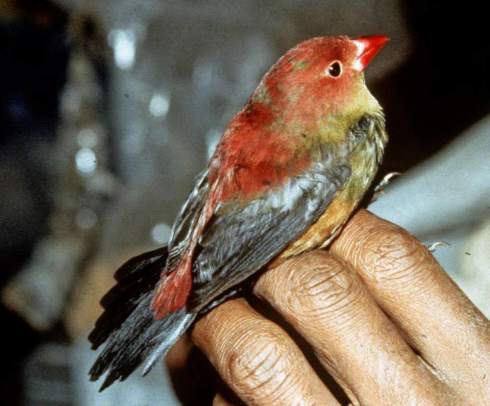
The world’s third known photograph of a Shelley’s crimsonwing.Photo Chicago Field Museum. Co-workers David Willard and Tom Gnoske
A new photo of a male Shelley’s crimsonwing
A so far unknown photo of a male Shelley’s crimsonwing was recently found. It was taken in 1990 by coworkers of Chicago’s Field Museum, an institution with a long-standing interest in African birds. Although the photo is 25 years old, it adds to our sparse knowledge of the most elusive of the four Cryptospiza species, but it also reminds us of what we do not know.
The (probably mist-netted) bird was hand-held and the photo was taken from an angle giving a dorso-lateral view of the male.

Shelley’s crimsonwing. Photo courtesy http://www.gorilla.org
This is a different perspective compared to the other two known photos, providing a lateral or ventral-frontal view. Why is this exciting? Because we get an impression of the back plumage. Interestingly, there is a slight yet significant difference compared to the back plumage that I know from museum skins of male Shelley’s crimsonwings.
The extent of the red colour seems lesser than on the skins that I know and possibly also lesser than on the other two photographed males.Apart from that, the red of the nape and hindneck is patchy, interspersed with patches of olive green feathers. It is tempting to speculate that the photo shows a relatively young bird in its first year, and that the red plumage parts of the males become more extent and intense as the birds get older.
Another aspect that caught my attention is the relatively broad white base of the beak. Its extent seems significantly broader than in the other two photos, and it may also be a feature associated with the age of the bird.
Another thing that is starting to puzzle me is the fact that the photo again shows a male bird. While this may still be pure chance, it may also be the result of differences in behaviour or spatial occurrence of the sexes that may make males more likely to being caught in a mist-net than females. And why were always single birds netted? The other crimsonwing species mostly appear to travel in pairs or small flocks. Does Shelley’s behave differently? Or were the females incubating eggs at the time when the three known males were caught? An alternative explanation may also be that the female population is in fact smaller than the male population.
It would be great to make contact with people at The Field Museum (Chicago) and find out more about their observations during expeditions to the Rwenzori mountains in the 1990s. Published expedition reports indicate that a larger number of birds (up to 20) were netted during an expedition in 1990/1991, and it would be a very valuable source of information to learn more about the circumstances under which this occurred. Where did the birds occur in such large numbers? This would be extremely valuable information for the RFCG in our quest for one of Africa’s rarest and most mysterious birds that has been ongoing for 10 years now.
Prof. Sven Cichon, PhD
Basel, Switzerland
-
SEE – CONSERVE – ENJOY
SHELLEY NEEDS YOUR HELP Exciting Shelley’s Expedition planned. Linked to two great Africa Ecotour Safari options
21 Oct-
Searching for Africa’s most elusive bird. By Dr.Chris Lotz
When asked the question “what is Africa’s most elusive bird species”, most birders would answer that it must be any of the flufftails, which are, of course, notorious. Or, perhaps they might answer that it could be one of the two pitta species lurking on this continent. But, given a systematic approach, it is actually quite possible to find and even photograph every single flufftail species given a few weeks of travel across Africa and Madagascar. Even the Critically Endangered Slender-billed Flufftail can be reliably seen with a bit of effort – As for the pittas, they certainly aren’t in any way easy, but we usually do find both species annually – our success rate for African Pitta in Mozambique and Green-breasted Pitta in Uganda must be about four in five attempts. At the start of the breeding season, we have exact stakeouts for these jewel-like species and so we’ve kind of “mastered” them and they no longer escape us.
Fewer birders would guess that the bird that we simply can’t find is a splendidly-colored finch occurring at extremely low densities in a tiny part of central Africa.

Shelley’s crimsonwing. Photo courtesy http://www.gorilla.org
While local birding guides in Uganda report the species every couple of years, there are only three known photos of the bird in the world. ( All are held in the hands of a field researcher and all are cock birds. There are currently no known photo references of a hen bird ) And we have never found one on any of our tours yet (despite the fact that we do marvelously well on all the other rare and localized species in the region). The finch we are talking about is the Shelley’s Crimsonwing (Cryptospiza shelleyi), an Albertine Rift Valley endemic with a total world population estimated at anything between 2500 and 10000 individuals.
The Albertine Rift is a westward branch of the famous Great Rift Valley, and it boasts a large number of endemic bird species occurring only in a tiny part of Africa where four countries meet: Uganda, Rwanda, Burundi and the Democratic Republic of the Congo (DRC).
The beautiful and spectacularly bio-diverse, forested mountains of the Albertine Rift straddle the border regions of these four countries. Shelley’s Crimsonwing is one of these Albertine Rift endemics skulking in the undergrowth of the mountain forests here. The DRC is a dangerous place to visit, and most birders focus on either Rwanda or Uganda when they want to find this rare finch. (But find the bird they don’t…!)
Classified as Vulnerable by Birdlife International, Shelley’s Crimsonwing is so poorly-known that scientists do not even have much of an understanding why it is so rare, and why it is apparently declining (also with very fluctuating numbers from year to year). The guess is that habitat destruction by humans is the main culprit, but it has also often been said that the species might be declining due to natural causes, albeit mysterious and puzzling ones!
Where to look for it:
- We wish we knew!
- However, it is known (among other places) from the following legendary birding forests (all of which are also famous for mountain gorilla trekking
-
-

Threatened Mountain Gorilla ( Gorilla beringei.beringei ) photo taken by Cheryl Mares and kindly donated to the RFCG
Nyungwe Forest in Rwanda
- The Mgahinga Gorilla Reserve straddling the border between Uganda, Rwanda and the DRC – this is often considered a top site within Uganda for the crimsonwing, but the reserve is often inexplicably ignored by many birding tour operators. But, we do visit this site annually, partly because it is one of the most accessible sites for the incomparable Rwenzori Turaco (which we reliably DO find, unlike the crimsonwing!). With the spectacular Virunga Volcanos as a backdrop, Mgahinga is certainly not an unpleasant place to spend a couple of days…!
-
- Bwindi Impenetrable Forest in Uganda – this is where several sightings over the last few years have been, including a nesting pair that gave a good number of birders a look (practically “twitchable”) – but one also has to understand the story might have been exaggerated like a fishing tale (no photos were taken!). The long walk down to Mubwindi Swamp at the Ruhizha section of Bwindi – compulsory for seeing another of Africa’s most desirable birds, African Green Broadbill – is probably best. The good news about Bwindi is there are no less than 43 finch species that can be seen in this tropical rain forest.
SHELLEY NEEDS YOUR HELP. Why not join us in August 2016 to help look for it ?
Day 1: Aug 22. Arrival at Kigali in Rwanda and drive to Kisoro in Uganda stay at Travelers Rest X4 nights.
Day 2: Aug 23 Birding Mgahinga.
Birding Mgahinga Gorilla Reserve. This is one of the classic sites for Shelley’s Crimsonwing but even though we’re spending three full days here and two full days at its other classic site, we guess that the chances of actually finding Shelley’s is perhaps one in four. Hopefully the spectacular Rwenzori Turaco and the great scenery (ancient volcanos) will entertain us regardless. And, with lots of luck, who knows we might even encounter gorillas which freely cross the nearby borders into the DRC and Rwanda as this reserve straddles three countries! Please note that the main aim of this expedition is to try and find and photograph Shelley’s Crimsonwing so we’ll very much spend the bulk of our time looking for this mega-elusive species – this means driving to the reserve each morning and walking a lot, sometimes uphill quite a lot (at both sites, Mgahinga and also Bwindi).
Day 3: Aug 24 Birding Mgahinga
Day 4: Aug 25 Birding Mgahinga
Day 5: Aug 26 Birding to Ruhija.
Ruhija in the famed Bwindi Impenetrable Forest boasts over 20 Albertine Rift endemics including African Green Broadbill – and of course good old Shelley’s. If we don’t find Shelley’s, there are three other crimsonwings in this forest. It’s also one of the world’s best-known sites for Mountain Gorilla, but if you want to see that then we suggest you join the Aug 1-19 birding and primate trip – as the current trip is a “hardcore” Shelley’s trip.
Overnight at Trekkers Tavern. Ruhija. Bwindi
Day 6: Aug 27 Birding in Ruhija. Overnight at Trekkers Tavern
Day 7: Aug 28 Birding in Ruhija.Overnight at Trekkers Tavern
Day 8: Aug 29 Transfer to Kigali and departure.
The cost is based on basic clean accommodation and meals, land cruiser vehicle with driver and fuel, guide fees, park entrance fees and drinking water in the car.
The land cruiser upon which the prices are based is the typical East African one with a popup roof, but not the newest one – and without air conditioning. This is the norm in Uganda. A surcharge would be payable for a truly good vehicle.
US$3738 per person sharing for a group of 4-5 paying participants, or $3230 for 6. There will be a small single supplement for those preferring a single room or if we can’t find someone to share a room with you. A separate price can be quoted if a Gorilla trek needs to be included.
This price includes a 10 % conservation donation to the Rare Finch Conservation Group which is a registered non-profit organisation.
We would like to try and get photos and sound recordings of the Shelley’s finch, one of Africa’s rarest finches. We plan to be as close as possible to the sites we feel are best for the species. We’d like to try and get publicity for this rare species (which will hopefully help its conservation). The trip will naturally also look at other bird and finch species in the area, but our main focus will be to try and find and see the threatened and elusive Shelley’s.
More about the two great Africa EcoTour options linked to the exciting Shelley’s Expedition experience
Join a birding and primate tour of Uganda from 1 -19 August before the Shelley’s Expedition starts, and / or join a Namibia, Botswana, Vic Falls tour after it. ( Maximum 8 per group ) Details of both trips are at ihttp://birdingecotours.com/tour/birding-tour-uganda-gorillas-and-chimpanzees-in-12-days-2015-2?type=country&where=Uganda and / or http://birdingecotours.com/tour/birding-tour-namibia-okavango-and-victoria-falls-18-day-2016. please note that while the latter trip is usually run later in the year, if we get at least four participants, we will add another departure of this trip from Sep 1-18, 2016.
Please e-mail info@birdingecotours.co.za for more details on the Shelley’s Expedition and the exciting two Birding Ecotour options to experience and enjoy Africa at its very best

Founded in 2005 The Rare Finch Conservation Group is registered in South Africa as a non-profit organisation. It is totally dependent on donors and sponsors to carry out its conservation work on finches. All donations will be publicly acknowledged , unless otherwise requested, on the RFCG website. Donations can be made to the following account. Rare Finch Conservation Group, Nedbank. Account number 1933 198885 Branch : Sandown 193 305 South Africa ( For international donors please add ) SWIFT NEDSZAJJ. -
SEE – CONSERVE – ENJOY
RFCG Receives an exciting new photo of the elusive and threatened Shelley’s crimsonwing
7 JulLast week Colin Jackson made contact with the Rare Finch Conservation Group and informed us that he had photographed the Shelley’s crimsonwing, whilst on an expedition in the Mt Tsiaberimu area, in the DRC, in 1997. We informed him that the only other known photograph of the species in the world, taken in 2008 and sourced from the website http://www.gorilla.org, was also photographed in the Mt Tsiaberimu area in the Virunga National Park, DRC.
This is what Colin Jackson shared with us ” Very interesting to hear of the story behind the other image of the crimsonwing – that it also came from Tsiaberimu…. We caught ours in the heart of the forest not far from where we first camped in nets going through the edge of bamboo and bordering an open area that included some swampy vegetation. The expedition was one of National Museums of Kenya staff, funded by the Berggorilla and Regenwald Direkthilfte and the Atlanta Zoo. A key objective of the expedition was to survey the surviving gorillas and Titus Imboma (whose hand is holding the bird in the image) and myself were taken along to do bird surveys.”
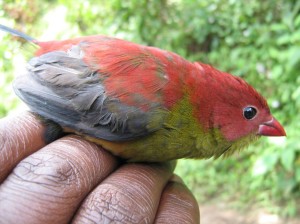
Ever since 2008 this was the only known photograph of a Shelley’s crimsonwing in the world. Photo courtesy http://www.gorilla.org
The RFCG would like to sincerely thank Colin Jackson for sharing this exciting new photograph of the species, with the rest of the world.
This is what the authoritative Birds of Africa Volumn 7 by C Hillary Fry et al tells us about the species. General Habits : Inhabits closed moist understory in montane forest, low secondary growth at forest edge, clearngs with Sericostachys, mixed bamboo thickets; Sometimes in more open areas by streams. Singly or in pairs : forages on ground for seeds; associates with other crimsonwings ( Unconfirmed reports given to the RFCG is that they are normally Dusky crimsonwings : Senegali de Jackson ). Shy elusive, seldom seen ; when flushed flies rapidly for short distance and dives for cover, and does not reappear.
These exact same observations have also been shared with the RFCG by bird guides working in the Ruhija area in the Bwindi Impenetrable Forest in Uganda. The breeding habits of the species are unknown. The IUCN Red data list classifies the species as Vulnerable ( A high risk of extinction )
The Rare Finch Conservation Group is registered in South Africa as a non-profit organisation and is dependant on donors and sponsors to carry out its conservation work on finches in the wild. For more info visit http://www.rarefinch.org or write to the secretary at editor@avitalk.co.za
SEE – CONSERVE – ENJOY

